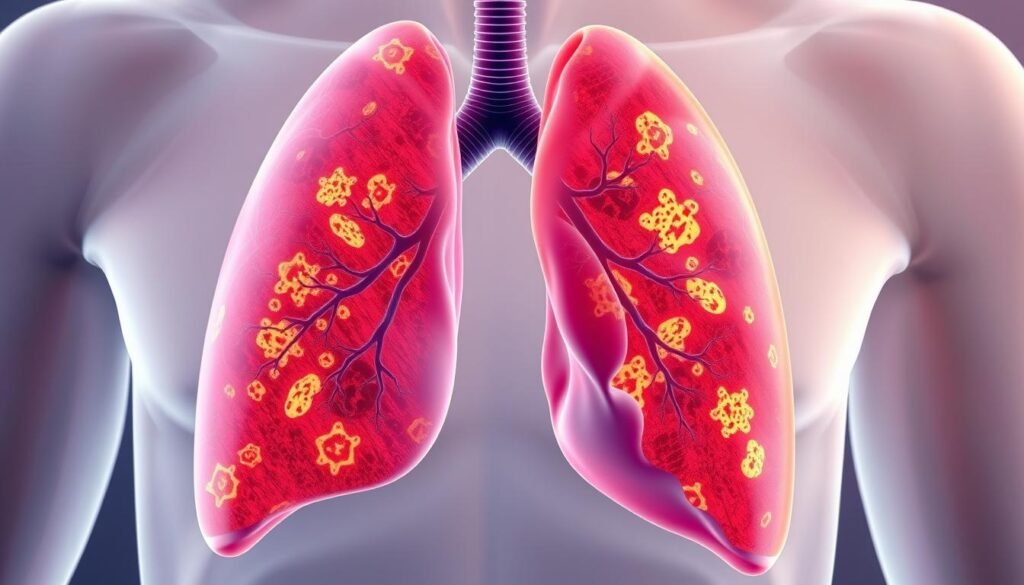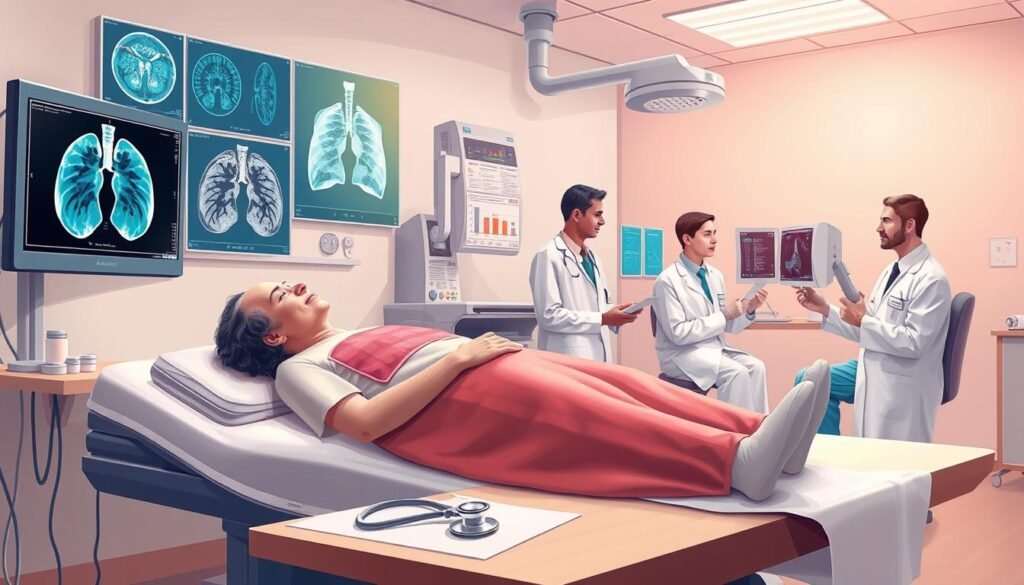Did you know that about 80% to 85% of lung cancer cases are non-small cell lung cancer (NSCLC)? This fact shows the importance of knowing about alveolar lung cancer. It comes from the lungs’ alveolar cells and is a major type of NSCLC. It greatly affects patients’ health and treatment results.
Detecting symptoms early is crucial for dealing with this disease. Advances in cancer research show that early discovery, especially through low-dose computed tomography (LDCT), can greatly increase the chances of survival. This guide will shed light on the symptoms of alveolar lung cancer. It will also cover the newest care and treatment options. For more details and data, visit this resource.
Key Takeaways
- Alveolar lung cancer is a subtype of non-small cell lung cancer.
- Recognizing symptoms early is crucial for effective treatment.
- Advancements in oncology enhance patient care strategies.
- Early detection improves survival rates significantly.
- Alveolar lung cancer derives from alveolar cells in the lungs.
Understanding Lung Cancer
Lung cancer starts in the lung tissues. It is mainly split into two types: non-small cell lung cancer (NSCLC) and small cell lung cancer (SCLC). NSCLC makes up about 85%–90% of all lung cancer cases. Small cell lung cancer, the other 10%, grows more quickly.
The lungs have different parts like lobes and bronchi. Cancer can grow in these areas, blocking normal lung function. This can cause big health problems. Finding lung cancer early can greatly help in treating it.
Many things increase the risk of getting lung cancer. Smoking is the biggest risk. Smokers are much more likely to get lung cancer than non-smokers. Even people who never smoked can get lung cancer. About 20% of NSCLC cases are in those who never smoked. Being around things like asbestos can also raise your risk.
Getting older, having lung cancer in your family, and breathing in secondhand smoke add to the risk. Living where the air is very polluted does too. Conditions like malignant pleural mesothelioma, while not lung cancer, share similar risk factors.
Learning about lung cancer is important. Knowing the symptoms and risks helps people make smart health choices. It might even lower the chance of getting this serious disease.
What is Non-Small Cell Lung Cancer?
Non-small cell lung cancer (NSCLC) is the most common type of lung cancer, making up about 85% of all cases. It includes different lung cancer types like adenocarcinoma, squamous cell carcinoma, and large cell carcinoma. Each type has unique features and affects patient outlook differently.
Knowing these differences is vital. It helps doctors choose the best treatment. This can greatly improve how well a patient does.
Many things can lead to NSCLC, but smoking is the number one cause. It’s behind over 80% of lung cancer deaths. Other risks include being around radon, known to cause about 21,000 lung cancer deaths in the U.S. yearly. Workplaces with dangerous materials and polluted air also raise the risk.
It’s very important to find lung cancer early to increase survival chances. Sadly, more than half of those with lung cancer pass away within a year of finding out they have it. The five-year survival rate for all types, including NSCLC, is below 18%.
Learning about NSCLC and its risk factors can help catch it sooner. This might boost the odds of successful treatment. Click here for more information.
| Lung Cancer Type | Percentage of Cases |
|---|---|
| Adenocarcinoma | 40% |
| Squamous Cell Carcinoma | 25–30% |
| Large Cell Carcinoma | 5–10% |
| Small Cell Lung Cancer | 15–20% |
Being aware of NSCLC symptoms is key to getting help early. Thanks to ongoing research, there are new ways to deal with this illness. This brings hope to those facing this challenge.
Types of Non-Small Cell Lung Cancer
Non-small cell lung cancer (NSCLC) includes adenocarcinoma, squamous cell carcinoma, and large cell carcinoma. These types have unique features that affect diagnosis and treatment. Each is linked to different risk factors.
Adenocarcinoma is the most common, making up about 40% of NSCLC cases. It starts in the mucus-producing cells. This type is found in both smokers and non-smokers. It’s also more common in younger people than other lung cancers.
Squamous cell carcinoma makes up around 30% of NSCLCs. There’s a strong link between it and smoking. Catching it early can greatly improve treatment.
Large cell carcinoma represents 10% to 15% of NSCLC cases. It grows fast and can spread quickly. Fast action is required to treat it.
Other NSCLC subtypes include adenosquamous carcinoma and sarcomatoid carcinoma. These are less common but still important. Each brings unique challenges for treatment and outcome.
Knowing these types helps with early detection and treatment. Watch for signs like a persistent cough, chest pain, or sudden weight loss. Early action can improve survival rates. For more info on these signs, see this guide.
Alveolar Lung Cancer Explained
Alveolar lung cancer is a special kind of adenocarcinoma that starts in the alveoli. These alveoli are vital for breathing, as they exchange gases in the lungs. This type of cancer is not very common. It makes up about 5% to 9% of all lung cancers. It’s important to learn more about it to understand how it acts in the body.
Definition and Origin
Alveolar lung cancer begins in the alveolar cells. These cells help with the exchange of oxygen and carbon dioxide. Most people who get this cancer are in their 60s or 70s. Sometimes, people find out they have it when a chest x-ray shows a shadow, even if they have no symptoms. The x-ray might show a single shadow, but rarely shows holes or calcium deposits. Knowing these details helps doctors recognize and treat this cancer.
Relationship with Adenocarcinoma
A lot of lung cancers are adenocarcinomas, making up 40% of cases. Alveolar lung cancer is a type of adenocarcinoma because of certain changes in cells. People with adenocarcinoma often have different risk factors, like smoking. Some genetic mutations can affect a person’s outlook. This shows how alveolar lung cancer and adenocarcinoma are linked, which highlights the need for special treatments and close watch over patients.

Symptoms of Alveolar Lung Cancer
Knowing the signs of lung cancer is key to early detection and treatment. Alveolar lung cancer, a type of non-small cell lung cancer, has distinct symptoms. These symptoms can greatly affect someone’s life, so it’s important to spot them early on.
Common Symptoms to Watch For
The early symptoms might not be obvious, but they are important to notice. These include:
- Coughing: A cough that stays could be a warning sign.
- Shortness of breath: Struggling to breathe during simple activities is a sign.
- Unexplained weight loss: If you’re losing weight without trying, it could mean something serious.
- Fatigue: Feeling tired all the time can be caused by fighting cancer.
If you notice these signs, see a doctor. Early checks can help find problems, especially for high-risk people.
Advanced Symptoms and Their Implications
As the cancer grows, symptoms get worse. Signs of advanced cancer include:
- Severe chest pain that gets worse with breathing or coughing.
- Frequent lung infections that don’t heal with usual treatment.
- Coughing up blood or rust-colored spit.
These signs of advanced cancer may mean it has spread. If your health is getting worse, you should get medical help right away. Being aware of lung cancer signs can help with getting better treatment results.
To stay informed on new treatments, check out the latest options. Go to latest treatments for lung cancer for more info.
Diagnosis and Staging
It’s very important to diagnose lung cancer accurately to treat it right. Doctors use many tests to find out if someone has lung cancer, especially a kind called alveolar lung cancer. Finding it early helps people get better faster.
Diagnostic Tests and Procedures
The first step in diagnosing lung cancer is often using imaging, like CT scans and X-rays. These imaging tests look for unusual spots in the lungs. If doctors see something odd, they may take a small piece of it to examine closely. This is called a biopsy. Biopsies can be done in different ways, such as:
- CT-guided biopsy
- Transbronchial biopsy
- Lobectomy
- Wedge resection or segmentectomy
By testing the biopsy, doctors can learn a lot about the cancer, like its type and how aggressive it might be. This information is crucial for choosing the best treatment.
Lung Cancer Staging Overview
After confirming lung cancer, the next step is to figure out its stage. Staging tells how much the cancer has spread in the lungs or to other parts of the body. It’s key for deciding how to treat it and knowing the patient’s outlook. The AJCC has specific rules for staging lung cancer, from stage I to stage IV.
For in-depth info on adenocarcinoma, a common type of lung cancer, you can visit this resource.

Treatment Options for Alveolar Lung Cancer
Recent years have seen big changes in treating alveolar lung cancer. Doctors now use the latest cancer insights to offer personalized care. Targeted therapy and immunotherapy are leading the way in tackling this cancer type.
Targeted Therapy Approaches
Targeted therapy zeroes in on cancer’s genetic flaws. It disrupts cancer growth without harming healthy cells. Options like EGFR inhibitors and ALK inhibitors improve patient outcomes.
This method is more precise than older treatments. It offers a softer way to fight the disease while still being effective.
Immunotherapy and Its Benefits
Immunotherapy is changing the game for alveolar lung cancer treatment. It boosts the body’s defense against cancer. Treatments like PD-1 inhibitors and CTLA-4 inhibitors offer long-lasting benefits.
Patients not only live longer but also enjoy better quality of life. As research advances, immunotherapy becomes more integrated into lung cancer care protocols.
Prognosis and Survival Rates
The chances of recovery from lung cancer depend on the cancer’s stage, a person’s health, and how well they respond to treatment. Knowing this helps us understand the survival rates for lung cancer patients. This knowledge is crucial for patients and families alike.
Factors Influencing Prognosis
Survival rates give us a glimpse into patient outcomes based on different factors. For example, the five-year survival rate for a certain type of lung cancer is almost 62%. This means the average survival time is over 6 years. It shows the importance of catching the disease early.
Whether you’re a man or a woman can affect your survival chances. Women have a higher five-year survival rate of 74%, while the rate for men is 37%. Also, having more than one tumor spots surprisingly increases survival to 85%. But, for those with a particular type of lung cancer, the rate drops to 20%.
Whether someone smokes also plays a role. Smokers have a five-year survival rate of 61%, which is better than non-smokers at 47%. This tells us how lifestyle choices can impact recovery chances.
Different surgeries also lead to different survival rates. Major surgeries have a survival rate of 60%, while smaller surgeries have a rate of 37%. This shows the importance of choosing the right type of surgery for your condition.
In conclusion, lung cancer survival depends on many things, including the stage of cancer, type of treatment, and the patient’s lifestyle. Focusing on early detection and tailored treatments can greatly improve chances of survival.
| Factor | Survival Rate | Notes |
|---|---|---|
| Overall BAC Patients | 61.9% | Mean survival time: 75.7 months |
| Women (BAC) | 74% | Significantly better than men |
| Men (BAC) | 37% | Lower survival rate |
| Multiple BAC Lesions | 85% | Higher survival confidence |
| Mixed Mucinous BAC | 20% | Significantly worse outcome |
| Smokers | 61% | Higher survival than non-smokers |
| Non-Smokers | 47% | Lower survival rate |
| Major Resections | 60% | Preferred surgical option |
| Wedge Resections | 37% | Lower survival but not statistically significant |

Living with Alveolar Lung Cancer
People facing alveolar lung cancer find great help in strong support systems and resources. These supports help with the emotional and psychological challenges that come with cancer. Finding the right support for lung cancer patients helps them be strong and guides them through their treatment.
Support Systems and Resources
Many patient resources are here to help those dealing with alveolar lung cancer. These resources include:
- Support groups, where people can share and get encouragement.
- Counseling services to tackle the emotional effects of cancer.
- Educational programs that teach patients and families about the disease, treatments, and how to cope.
- Online communities and forums for connecting with others in similar situations.
Using these resources makes the journey of living with cancer better. It also gives patients and their families the power to face cancer with more knowledge and strength.
| Resource Type | Description | Benefits |
|---|---|---|
| Support Groups | Gatherings where patients share experiences. | Emotional support, peer connection. |
| Counseling Services | Professional mental health support. | Emotional stability, coping strategies. |
| Educational Programs | Information sessions on lung cancer. | Knowledge, empowerment for decision-making. |
| Online Communities | Digital platforms for patient interaction. | 24/7 connection, advice sharing. |
As healthcare changes, knowing about patient resources supports dealing with cancer in a complete way.
Conclusion
Alveolar lung cancer is a big health concern. It shows how tough diagnosing and treating this condition can be. Knowing about adenocarcinoma, which makes up more than 40% of lung cancers, shows why treatment and support are so vital. Surgical advances, especially for a certain type of adenocarcinoma, offer hope for better survival rates. This makes knowing about this disease and getting help early very important.
There’s a link between lung diseases like PAP and lung cancer that can’t be ignored. People with certain lung diseases are at a higher risk of getting lung cancer. This means they need close watching and care. The successes seen with tumor treatments in the past highlight how important it is to get involved with healthcare. For a deeper look into how lung cancer progresses, check out this article: learn more about alveolar macrophages and lung.
Building supportive communities and catching the disease early are key to helping patients and their families. Knowing the signs and using resources can make a big difference in treatment. Keeping informed and connected is crucial for those affected by this illness.